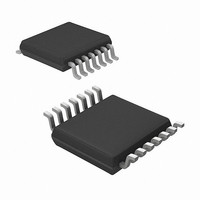MRF49XA-I/ST Microchip Technology, MRF49XA-I/ST Datasheet - Page 75

MRF49XA-I/ST
Manufacturer Part Number
MRF49XA-I/ST
Description
IC RF TXRX 433/868/915 16-TSSOP
Manufacturer
Microchip Technology
Datasheet
1.MRF49XA-IST.pdf
(102 pages)
Specifications of MRF49XA-I/ST
Package / Case
16-TSSOP
Frequency
433MHz, 868MHz, 915MHz
Data Rate - Maximum
256kbps
Modulation Or Protocol
FHSS, FSK
Applications
Home / Industrial Automation, Remote Access, Security Alarms
Power - Output
7dbm
Sensitivity
-110dBm
Voltage - Supply
2.2 V ~ 3.8 V
Current - Receiving
11mA
Current - Transmitting
15mA
Data Interface
PCB, Surface Mount
Antenna Connector
PCB, Surface Mount
Operating Temperature
-40°C ~ 85°C
Number Of Receivers
1
Number Of Transmitters
2
Wireless Frequency
433 MHz to 915 MHz
Output Power
+ 7 dBm
Operating Supply Voltage
2.5 V, 3.3 V
Maximum Operating Temperature
+ 85 C
Mounting Style
SMD/SMT
Minimum Operating Temperature
- 40 C
Modulation
FHSS, FSK
Lead Free Status / RoHS Status
Lead free / RoHS Compliant
Memory Size
-
Lead Free Status / Rohs Status
Lead free / RoHS Compliant
Other names
579-MRF49XA-1/ST
Available stocks
Company
Part Number
Manufacturer
Quantity
Price
Company:
Part Number:
MRF49XA-I/ST
Manufacturer:
IR
Quantity:
450
Part Number:
MRF49XA-I/ST
Manufacturer:
MICROCHIP/微芯
Quantity:
20 000
The following guidelines explain the requirements of
the above mentioned layers.
• It is important to keep the original PCB thickness,
• For good transmit and receive performance, the
• Except for the antenna layout, avoid sharp cor-
• Digital lines are prone to be very noisy when
• A VIA filled ground patch underneath the IC
• Power supply must be distributed to each pin in a
• Thorough decoupling on each power pin is
• Passive component (inductors) should be in the
© 2009 Microchip Technology Inc.
since any change will affect antenna performance
(see total thickness of dielectric) or microstrip
lines’ characteristic impedance.
trace lengths at RF pins must be kept as short as
possible. Using small, surface mount components
(in 0402/0603 package) yields good performance
and keeps the RF circuit small. RF connections
should be short and direct.
ners since they can act as an antenna. Round
corners will eliminate possible future EMI
problems.
handling periodic waveforms and fast
clock/switching rates. Avoid RF signal layout
close to any of the digital lines.
transceiver is mandatory.
star topology and low-ESR capacitors must be
placed at each pin for proper decoupling noise.
beneficial for reducing in-band transceiver noise,
particularly when this noise degrades perfor-
mance. Usually, low value caps (27-47 pF)
combined with large value caps (100 nF) will
cover a large spectrum of frequency.
high-frequency category and the Self Resonant
Frequency (SRF) should be at least two times
higher than the operating frequency.
Preliminary
• The additional trace length affects the crystal
• Setting short and direct connections between the
• Long run tracks of clock signal may radiate and
• Keep clock connections as short as possible and
• Low value decoupling capacitors, typically
• High value decoupling capacitors, typically
• Power supply bypassing is necessary. Poor
oscillator by adding parasitic capacitance to the
overall load of the crystal. To minimize this, place
the crystal as close as possible to the RF device.
components on board minimizes the effects of
“frequency pulling” that might be introduced by
stray capacitance. It even allows the internal load
capacitance of the chip to be more effective in
properly loading the crystal oscillator circuit.
cause interference. This can degrade receiver
performance and add harmonics or unwanted
modulation to the transmitter.
surround the clock trace with an adjacent ground
plane pour. Pouring helps in reducing any radia-
tion or crosstalk due to long run traces of the clock
signal.
0.01-0.1 μF, should be placed for V
and for bias points of the RF circuit.
2.2-10 μF, should be placed at the point where
power is applied to the PCB.
bypassing contributes to conducted interference
which can cause noise and spurious signals to
couple into the RF sections, significantly reducing
performance.
MRF49XA
DS70590B-page 73
DD
of the chip












